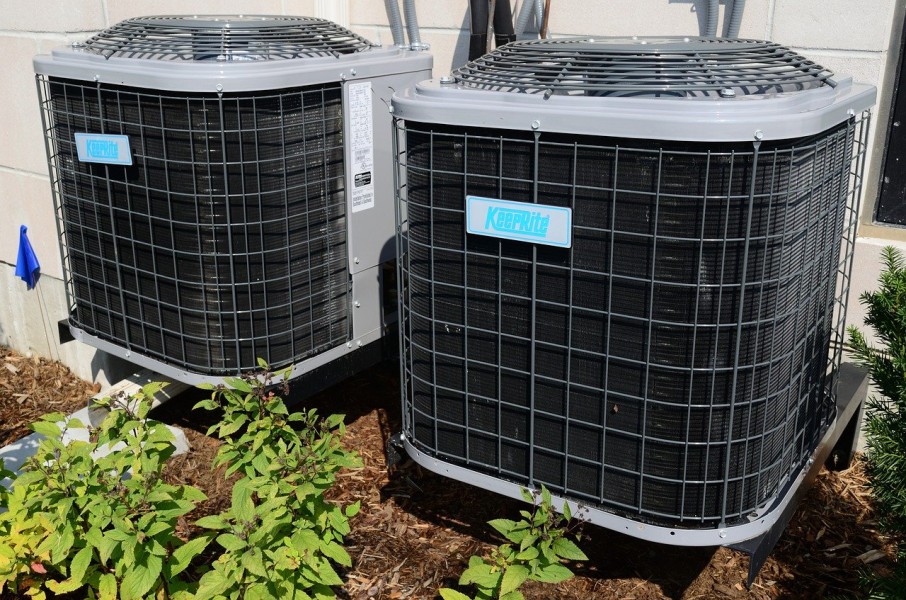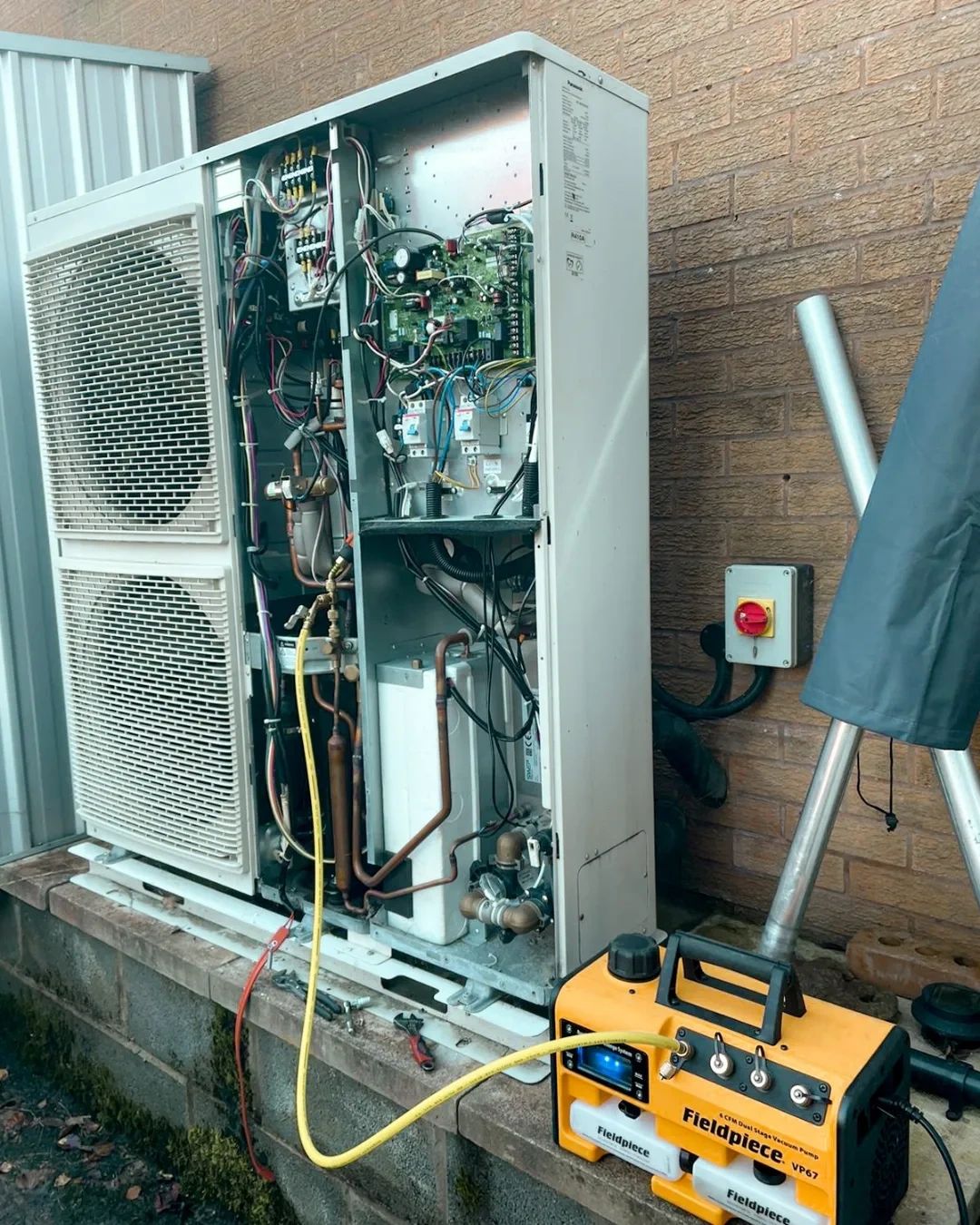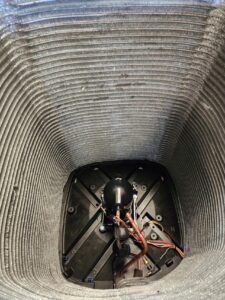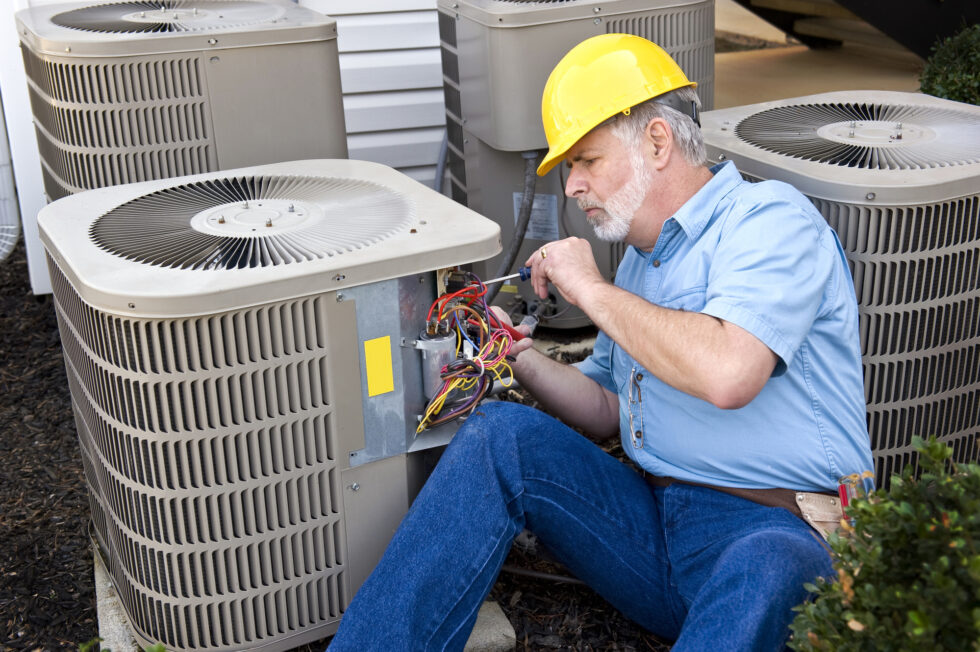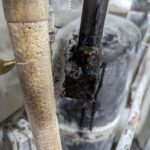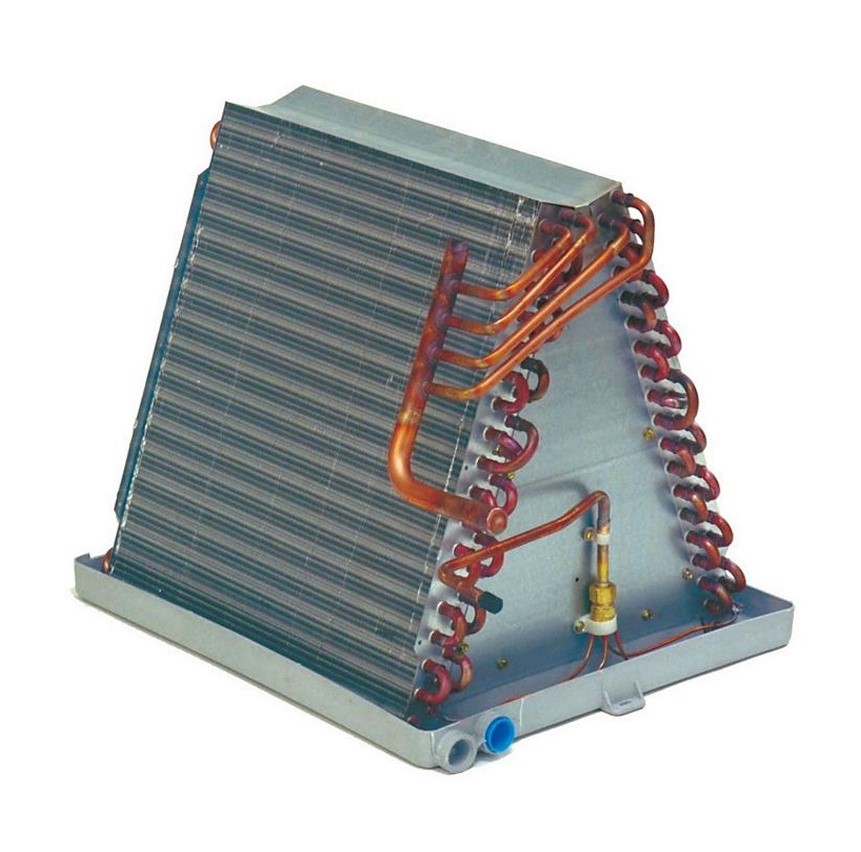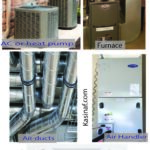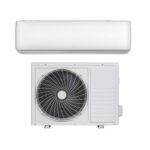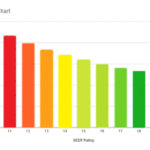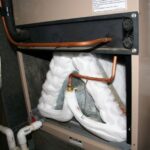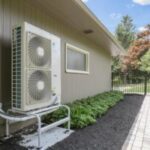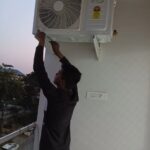heating and cooling pump systems
Heat pumps provide an energy-efficient option for both heating and cooling, serving as an alternative to traditional furnaces and air conditioners. They operate similarly to how your refrigerator works, using electricity to transfer heat from a cooler area to a warmer one. In colder weather, heat pumps extract heat from the outdoor air and bring it inside to warm your home. Conversely, during warmer months, they remove heat from your home and release it outdoors to keep the indoor space cool. Unlike furnaces that generate heat, heat pumps excel in efficiency by moving existing heat, contributing to comfortable temperatures in your home.
Types of heat pumps
There are three different types of heat pumps which include;
- Air-Source Heat Pumps (Air-to-Air): These heat pumps collect heat from the outdoor air and concentrate it for indoor use. They work well in various climates and are commonly used for both heating and cooling homes.
- Water Source Heat Pumps: This type of heat pump gathers heat from a water source, such as a nearby lake, pond, or well, and concentrates it to heat your home. They’re efficient but typically require access to a water body or a well for installation.
- Geothermal Heat Pumps: Geothermal heat pumps utilize the stable temperature of the ground below the surface to extract heat for indoor use. They tend to be highly efficient but may require more initial investment for installation, as they involve digging or drilling into the ground. However, they can offer significant long-term energy savings.
Air-Source Heat Pumps
These are also known as Air to air heat pumps,
Air source heat pumps are divided into two categories which include;
- Ducted air source heat pumps
- Ductless air source heat pumps
Understanding Air Source Heat Pumps
Air-source heat pumps are the most common type used to move heat between your home and the air outside. These pumps are impressive—they can cut down your heating electricity usage by around 65% compared to other electric heating methods like furnaces or baseboard heaters.

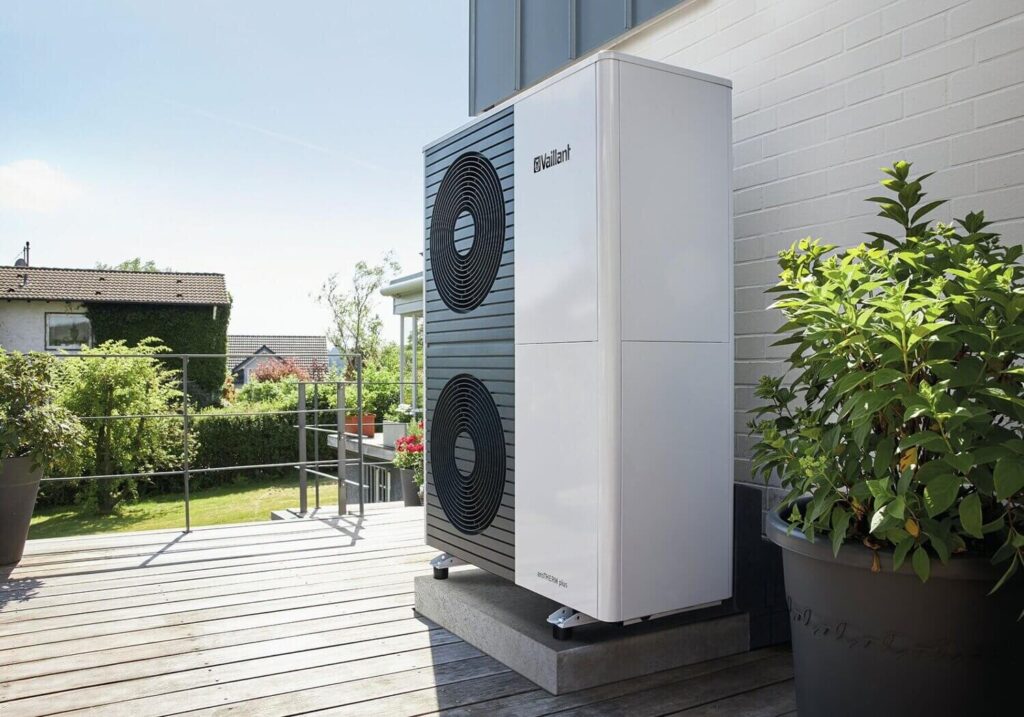
What’s really cool about high-efficiency heat pumps is that they don’t just cool your home; they also take out the extra moisture better than regular central air conditioners. This means they use less energy while keeping your home nice and comfortable during hot months.
In the past, air-source heat pumps were used almost everywhere in the United States, except in places that get super cold for long periods. But things have changed. Thanks to advancements in technology, air-source heat pumps now work well even in colder areas. That means they’re a real option for heating homes in colder places nowadays.
Pros and cons of air source heat pumps
Advantages and disadvantages of air source heat pumps
Pros of Air Source Heat Pumps:
High Energy Efficiency: Air source heat pumps demonstrate excellent efficiency, often with SEER ratings in the mid-20s (Seasonal Energy Efficiency Ratio) and HSPF ratings (Heating Seasonal Performance Factor) significantly higher than traditional heating systems, offering substantial energy savings.
- Long Lifespan and Low Maintenance: They have a lifespan of about 15-20 years and typically require minimal maintenance, needing cleaning every few months and servicing annually.
- Less Power Consumption: These pumps use electricity primarily for internal operations, resulting in reduced electricity bills. Some models can also be powered by renewable energy sources like solar or wind, further reducing overall consumption.
- Relative Affordability: While initial costs can be higher than traditional systems, air source heat pumps are generally more affordable than geothermal heat pumps, providing a cost-effective alternative.
Cons of Air Source Heat Pumps:
- Climate Sensitivity: Air source heat pumps might struggle in extremely cold climates, impacting their efficiency and heating capacity. Geothermal heat pumps are more reliable in such conditions.
- Relatively high noise Levels: Some air source heat pumps can generate noticeable operational noise. Proper installation and distance from the home can mitigate this issue.
- Long warm-Up Time: They might take longer to heat spaces compared to traditional systems, leading to a potential initial discomfort in colder weather.
Air source heat pumps offer commendable energy efficiency, longevity, and moderate costs compared to alternatives. However, their effectiveness can vary in extremely cold climates, and they might produce some operational noise while taking a bit longer to warm up spaces. Overall, they remain a promising and environmentally friendly heating and cooling solution for many regions.
Ductless Air-Source Heat Pumps
For houses lacking ductwork, there’s a solution: ductless air-source heat pumps, often known as mini-split heat pumps.
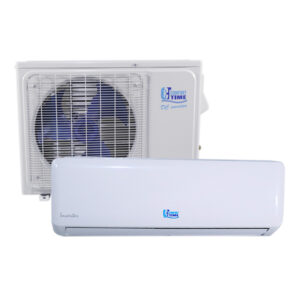
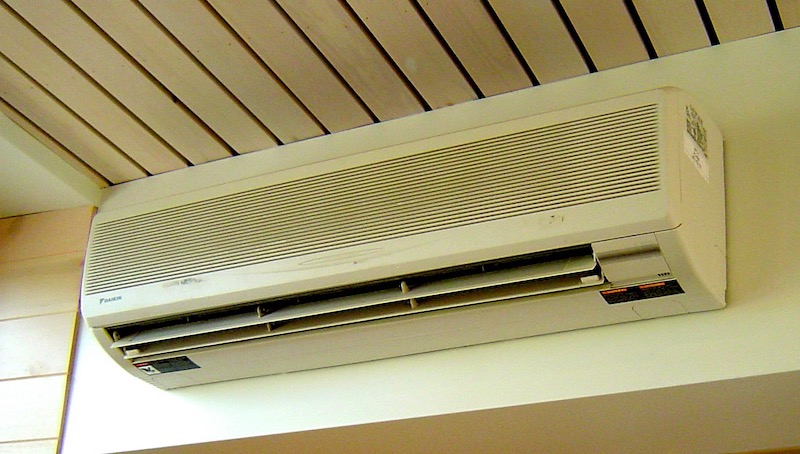
These versions work without ducts, providing heating and cooling directly into specific zones or rooms. Additionally, there’s a unique type known as a “reverse cycle chiller.” Unlike regular heat pumps that control air temperature, this one produces hot and cold water.
This feature enables it to partner with radiant floor heating systems, delivering warmth through the floors instead of the air, particularly in heating mode. It offers a different approach to heating for homes without ducts, making it versatile and adaptable to various heating needs.
Geothermal heat pumps
Geothermal heat pumps—also known as ground-source or water-source heat pumps—achieve remarkable efficiency by transferring heat between your home and the stable temperatures of the ground or nearby water sources. Despite higher installation costs, these pumps boast low operating expenses because they tap into the consistent temperatures underground or in water bodies.
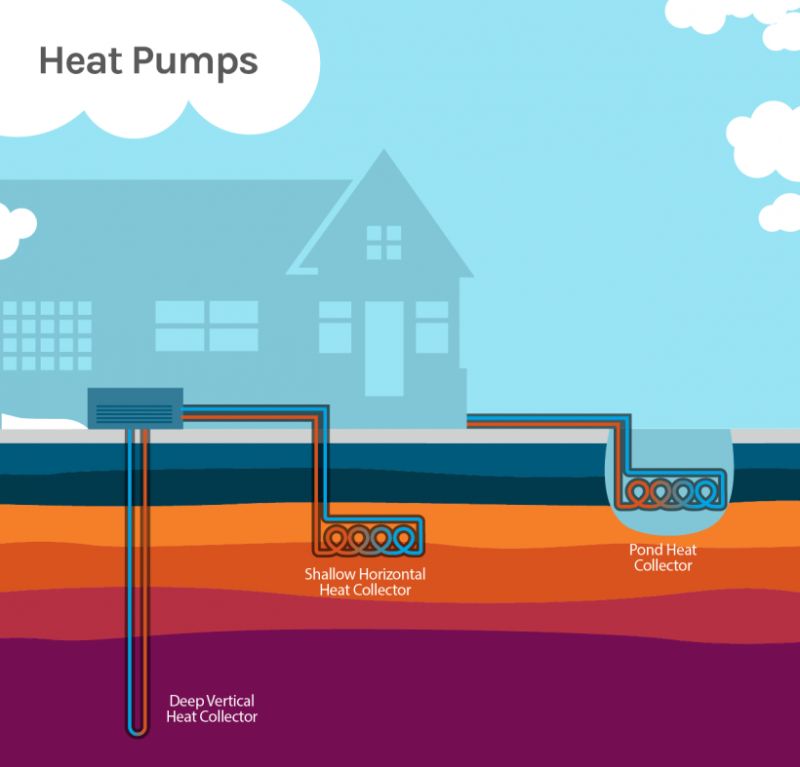
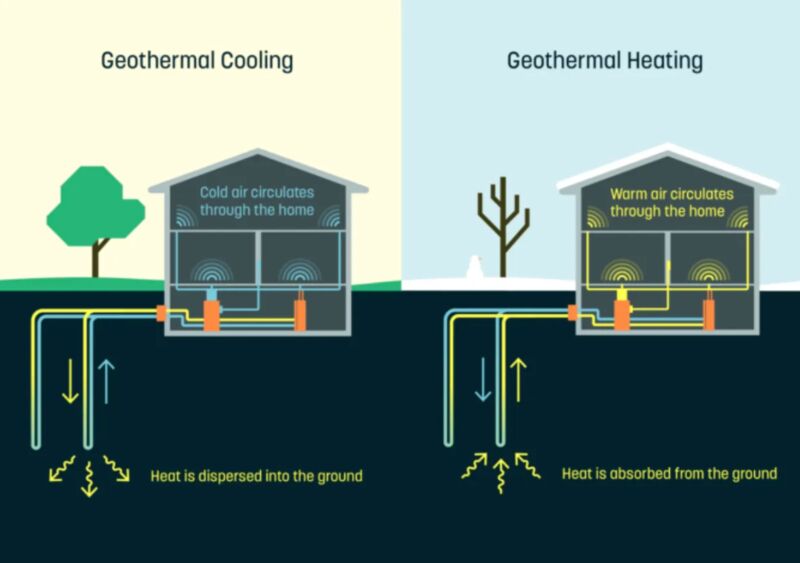
Their advantages are substantial: reducing energy usage by 70%-80%, maintaining humidity levels, ensuring durability, reliability, and compatibility with various home setups. However, whether a geothermal heat pump suits your needs depends on factors like lot size, soil composition, and landscape features.
These pumps excel in extreme climates compared to air-source heat pumps, and users express high satisfaction with their performance. Geothermal heat pumps represent a robust and efficient heating and cooling solution, leveraging the stable temperatures found below the ground or in water sources for substantial energy savings and comfort.
commercial Geothermal heat pumps
Project A
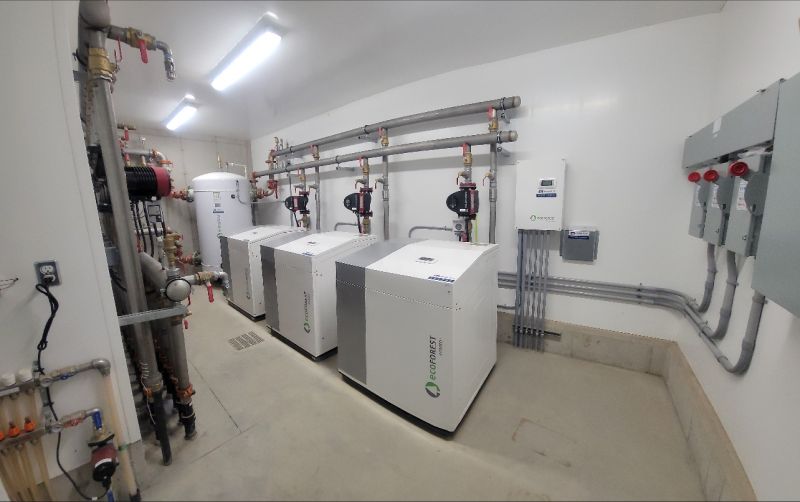
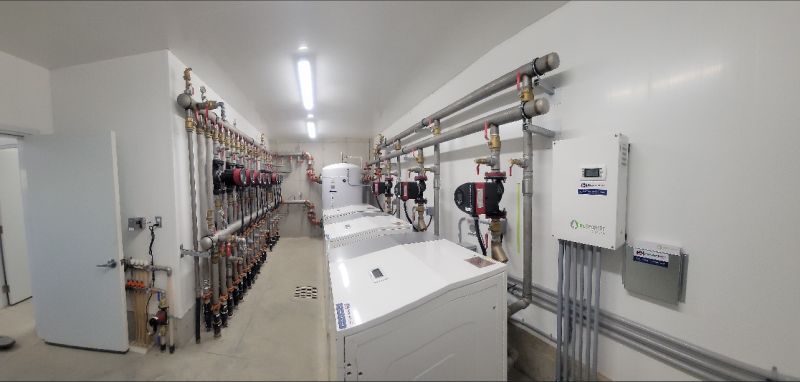

project B
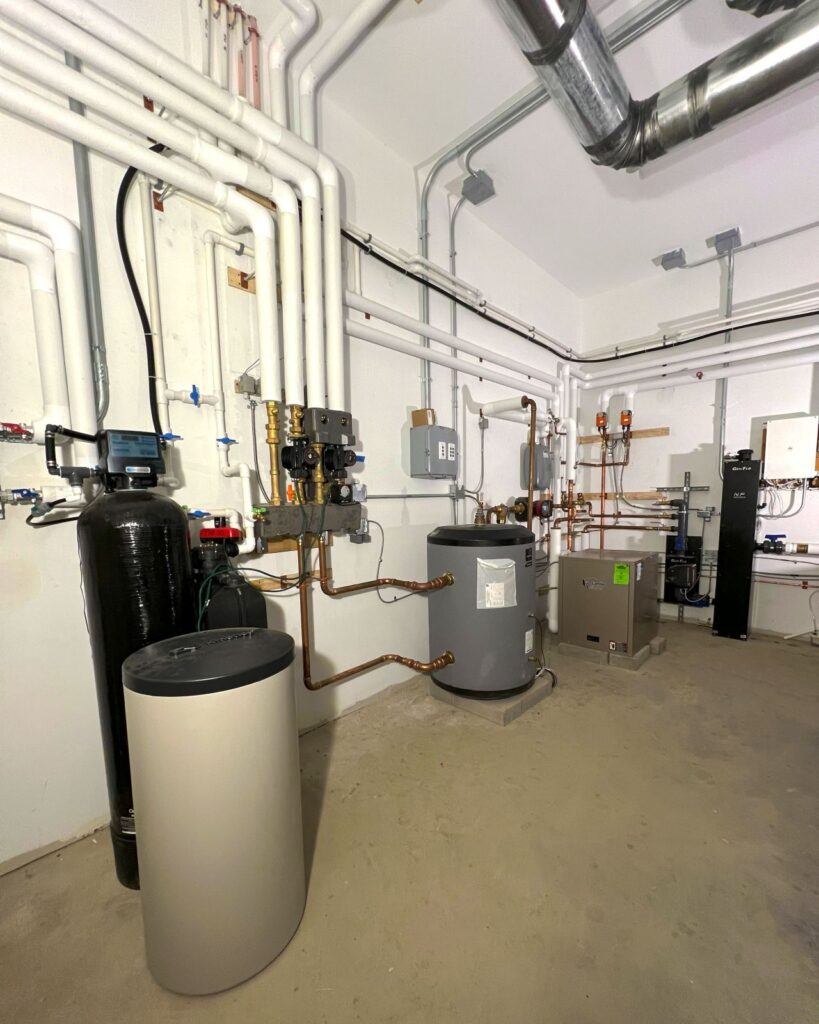
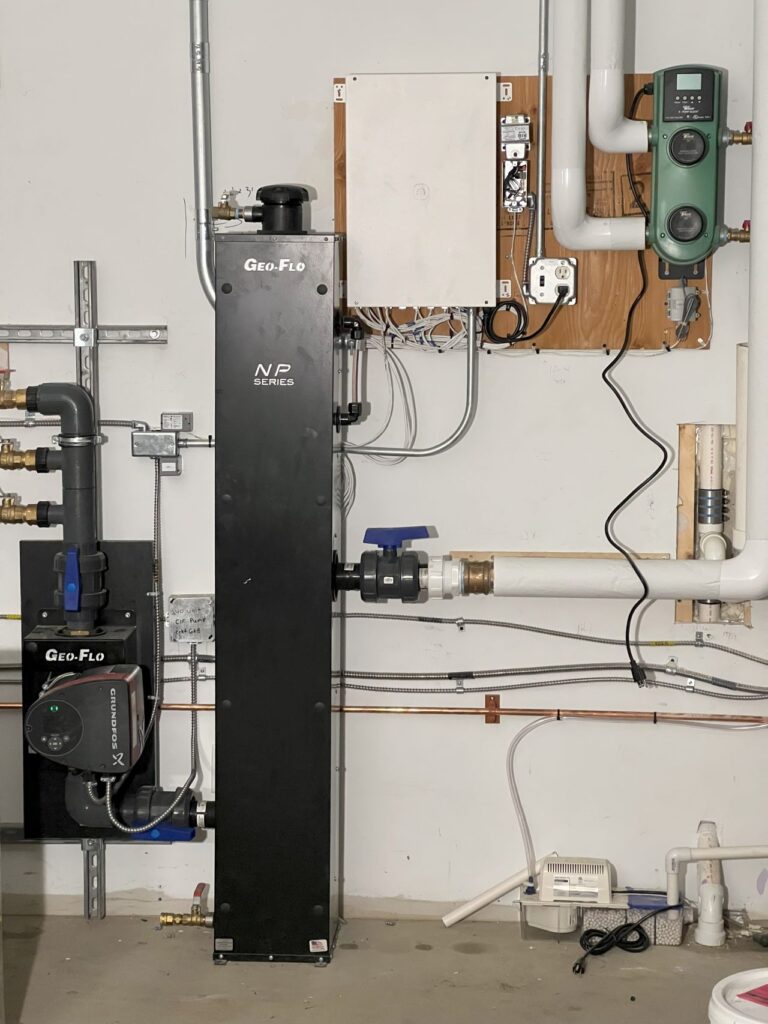
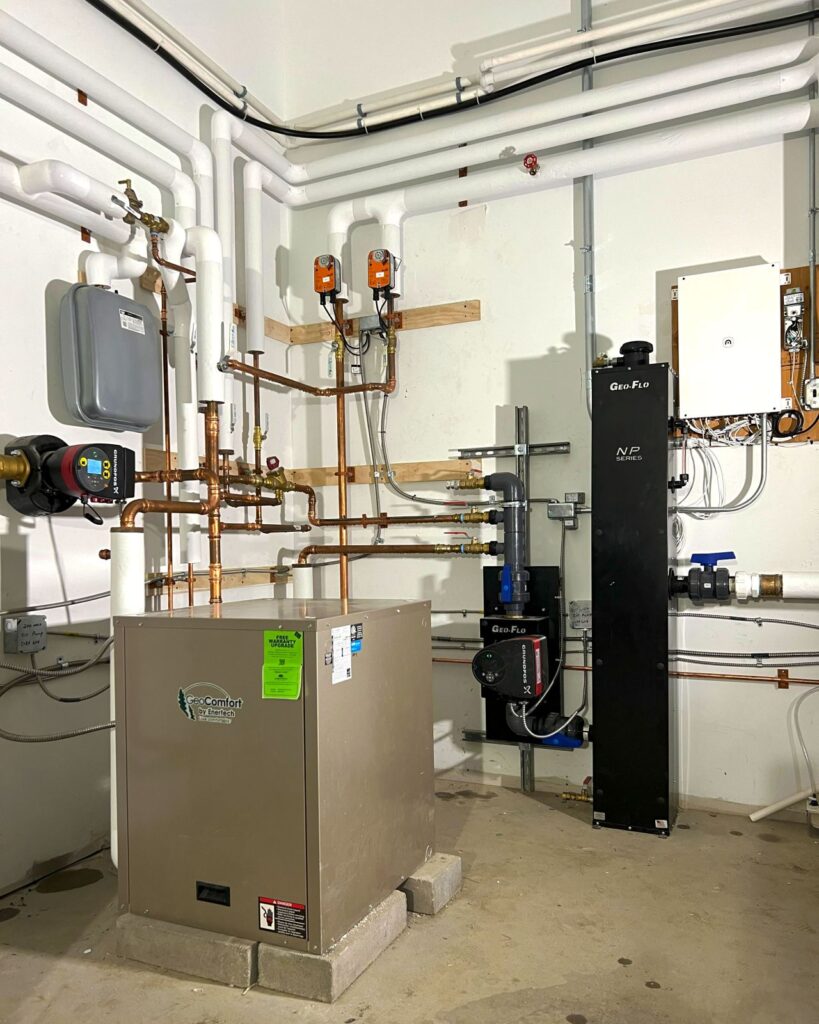
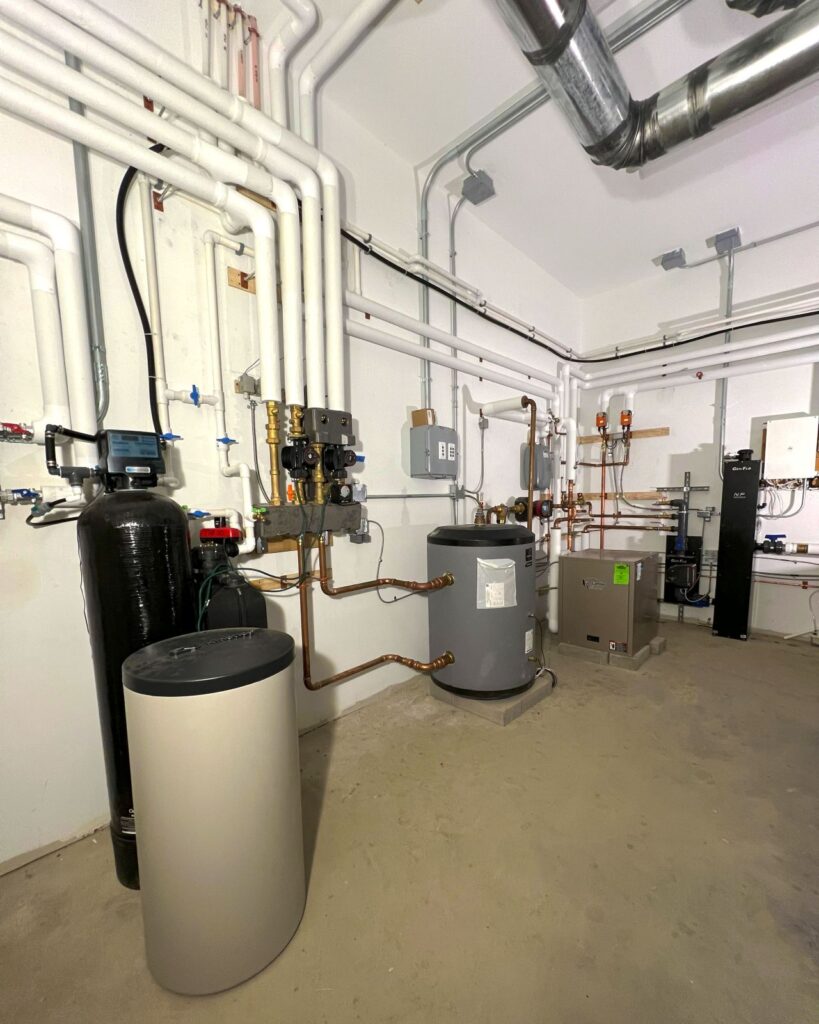
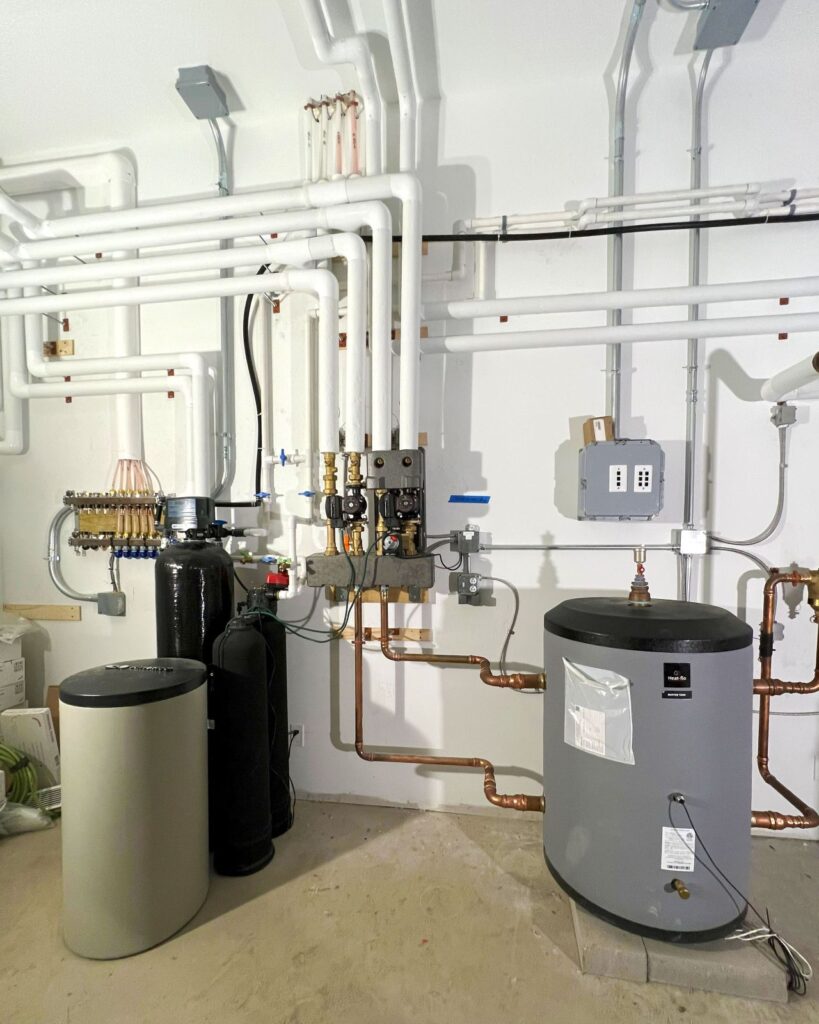
Advantages of geothermal heat pumps
Geothermal heat pumps offer several advantages:
- High Efficiency: They achieve impressive efficiency by utilizing stable ground or water temperatures, resulting in significant energy savings compared to traditional heating and cooling systems.
- Lower Operating Costs: Despite higher installation expenses, geothermal heat pumps have lower operating costs due to their reduced energy consumption, leading to long-term savings on utility bills.
- Humidity Control: These pumps effectively manage humidity levels indoors, enhancing overall comfort in the home.
- Durability and Reliability: Geothermal systems are known for their durability and reliability, often requiring less maintenance compared to other heating and cooling solutions.
- Suitability for Extreme Climates: Geothermal heat pumps perform well in extreme climates, making them a reliable option in areas with harsh weather conditions.
Disadvantages of Geothermal heat pumps
Geothermal heat pumps have some drawbacks:
- High Initial Cost: The upfront installation expenses for geothermal systems are typically higher compared to traditional heating and cooling systems. This initial investment can deter some homeowners, despite the long-term savings.
- Site Requirements: Geothermal systems require adequate space for installation, including access to land for ground loops or a nearby water source. Limited space or unsuitable soil conditions can restrict installation options.
- Complex Installation: The installation process for geothermal heat pumps can be complex and may require specialized expertise. This complexity can contribute to higher installation costs.
- Potential System Disruption: Any issues with the ground loops or underground components might require excavation or disruption to the landscape, leading to inconvenience or additional expenses for repairs.
- Not Ideal for Every Location: While geothermal systems work well in many areas, their efficiency can vary depending on geological conditions. Some regions may not have suitable ground or water conditions for optimal system performance.
Despite these drawbacks, the long-term energy savings, efficiency, and environmental benefits of geothermal heat pumps often outweigh these initial limitations for homeowners seeking sustainable heating and cooling solutions.
Absorption Heat Pumps
A newer addition to residential heating systems is the absorption heat pump (AHP), also known as a gas-fired heat pump. Unlike traditional compression heat pumps that rely on mechanical energy, AHPs operate using heat or thermal energy as their primary source. They can run on various heat sources such as natural gas combustion, steam, solar-heated water, air, or geothermal-heated water.
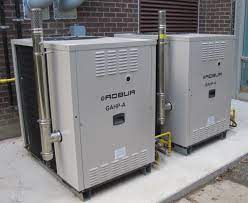
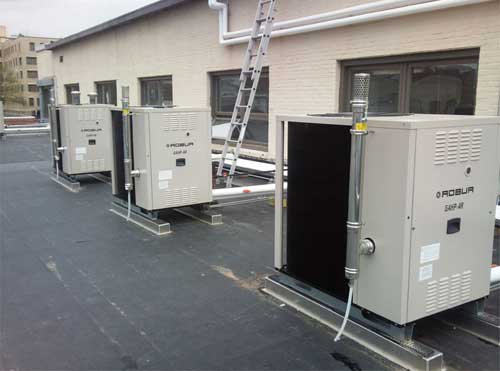
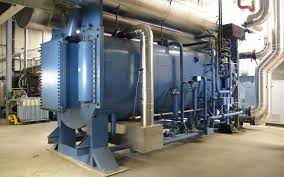
However, absorption heat pumps differ from compression pumps as they’re more intricate and typically require larger units. The reduced electricity usage in AHPs is primarily due to the liquid pumping process they employ. These pumps represent an alternative technology for heating systems, leveraging diverse heat sources for operation and offering reduced reliance on electricity.
To Maximize efficiency, here are the advanced Features to Look for in a Heat Pump
In the world of heating and cooling, innovation is shaping the performance of heat pumps. These advancements aim to revolutionize how heat pumps function, offering increased efficiency and superior performance.
Two-Speed Compressors in heat pumps
Unlike traditional compressors limited to operating at full capacity, two-speed compressors adapt to the required heating or cooling capacity based on outdoor temperatures. This not only conserves energy by minimizing on/off operation but also reduces wear on the compressor. These models excel when paired with zone control systems, maintaining different room temperatures efficiently.
Two-speed compressors in heat pumps are specialized components that offer two levels of operation, allowing the system to adjust its heating or cooling capacity based on outdoor temperature conditions.
These compressors function at different speeds: low and high. During milder weather, the compressor operates at a lower speed, providing just enough heating or cooling to maintain indoor comfort levels without using excessive energy.
When outdoor temperatures become more extreme, the compressor switches to a higher speed, delivering greater heating or cooling capacity to match the increased demand.
Two-speed compressors enable the heat pump to modulate its performance, optimizing energy usage by avoiding frequent cycling on and off, a process that can contribute to energy waste and increased wear on the compressor. This adaptive capability helps in achieving more efficient operation and maintaining consistent comfort levels in various weather conditions.
Top of Form
Advantages of two speed compressors in heat pumps
Two-speed compressors in heat pumps offer several advantages:
- Energy Savings: They adjust their capacity to match the heating or cooling needs precisely, reducing energy consumption by operating at lower capacities when full power isn’t necessary.
- Reduced Wear and Tear: By minimizing the need for frequent on/off cycling, two-speed compressors experience less wear and tear, extending the lifespan of the compressor and the overall system.
- Compatibility with Zone Control: Two-speed compressors complement zone control systems, allowing the heat pump to manage different room temperatures efficiently. This compatibility optimizes comfort and energy efficiency throughout the house, especially in larger homes with multiple zones.
- Improved Comfort: These compressors maintain a more consistent indoor temperature by fine-tuning the heating or cooling output based on outdoor conditions, providing enhanced comfort for occupants.
- Efficient Operation: They optimize the heat pump’s performance, ensuring it operates at the most efficient levels according to the required heating or cooling demands, resulting in better overall efficiency.
- Quiet Operation: Two-speed compressors often run at lower capacities, leading to quieter operation compared to single-speed compressors, contributing to a more peaceful indoor environment.
The drawbacks of two-speed compressors in heat pumps include potentially higher initial costs, increased complexity in installation and maintenance, potential compatibility issues with existing systems, and potentially higher repair or replacement costs compared to single-speed compressors.
Overall, the adaptability and efficiency of two-speed compressors make them a valuable component in heat pumps, offering improved energy efficiency, comfort, and system longevity.
Variable-Speed Motors for heat pumps
Variable-speed motors in heat pumps are advanced components that regulate the speed of indoor and outdoor fans (blowers) within the system. These motors operate at varying speeds, adjusting to meet specific heating or cooling demands more precisely.
These motors aim to maintain a consistent airflow at an optimal velocity throughout the home, minimizing cool drafts and ensuring maximum comfort. By adjusting fan speeds dynamically, they reduce electrical consumption and contribute to energy savings.
Variable-speed motors also work to minimize operational noise by preventing the fans from constantly running at maximum speed, creating a quieter indoor environment.
Their adaptive functionality enables more efficient operation compared to fixed-speed motors, optimizing the overall performance of the heat pump system and enhancing comfort while minimizing energy consumption.
Advantages of heat pumps with variable speed fan motors
Variable-speed motors in heat pumps offer several advantages:
- Comfortable Airflow: These motors regulate indoor and outdoor fan speeds, ensuring the air moves at an optimal velocity, minimizing cool drafts, and maintaining consistent comfort levels throughout the space.
- Energy Efficiency: By adjusting fan speeds according to the required heating or cooling demands, variable-speed motors optimize energy consumption, resulting in significant electrical savings compared to fixed-speed motors.
- Noise Reduction: Variable-speed controls prevent fans from running at maximum speed constantly, reducing operational noise levels from the blower, contributing to a quieter indoor environment.
- Enhanced Efficiency: The ability to fine-tune fan speeds ensures more efficient operation, maximizing the overall efficiency of the heat pump system.
In summary, variable-speed motors in heat pumps offer improved comfort, energy savings, reduced noise, and enhanced system efficiency, making them a valuable feature for modern heating and cooling systems.
Dual-Fuel Systems
A dual fuel system in heat pumps is a hybrid HVAC setup combining two primary heating methods: a heat pump and a furnace. This system optimizes energy efficiency by leveraging the strengths of each component based on external temperature conditions.
The heat pump, which functions similarly to an air conditioner during warmer months, transfers heat from indoors to outdoors. In milder weather, it efficiently extracts heat from the environment to warm the indoors.
When temperatures drop significantly, the furnace, usually fueled by natural gas or propane, takes over. Furnaces specialize in rapid and intense heating, ensuring efficient warmth during colder spells.
The dual fuel system intelligently switches between these two heating sources based on outdoor temperatures, aiming to maximize efficiency. It uses the heat pump’s efficiency during milder weather and the furnace’s rapid heating capability in colder climates. This dynamic adaptation optimizes energy usage, ensuring effective climate control throughout the year.
Determining the Viability of Dual Fuel Systems
Variable Climate Considerations
In regions experiencing diverse temperatures, dual fuel systems offer a comprehensive solution. Furnaces efficiently generate rapid heat in consistently cold areas, while heat pumps excel in milder climates, providing both heating and cooling capabilities.
Energy Efficiency and Regulatory Compliance
Environmental regulations are steering HVAC preferences. Furnaces relying on gas might conflict with evolving energy efficiency laws, such as California’s 2022 Energy Code favoring heat pump efficiency, aligning with future eco-friendly HVAC trends.
Personal Comfort and Climate Impact
Furnaces often produce hot, dry heat, impacting personal comfort in winter. This dryness can affect skin moisture levels. Consulting HVAC experts can guide towards suitable solutions for individual comfort needs, addressing concerns about dryness and climate impact.
Advantages of Dual fuel system in heat pump
Dual fuel systems, a hybrid of a heat pump and a furnace, offer numerous advantages for home climate control:
Integrated Heating and Cooling: This system combines the strengths of a heat pump and a furnace, optimizing heating and cooling throughout the year. In summer, the heat pump functions like an air conditioner, while in milder seasons, it efficiently provides heat.
Adaptability to Climate: Furnaces excel in rapid heating, ideal for predominantly cold areas. Heat pumps, versatile for both heating and cooling, suit milder climates but may struggle in freezing temperatures.
Efficient Operations: Dual fuel systems intelligently switch between the heat pump and furnace as needed, optimizing energy consumption and ensuring faster heating or cooling.
Extended Lifespan: With a lifespan of 20 to 25 years, these systems offer prolonged efficiency and performance due to their adaptable and optimized operation.
Environmental Considerations: Dual fuel systems align with energy efficiency regulations, offering a greener solution where environmental mandates favor eco-friendly HVAC options.
In summary, dual fuel systems combine the best qualities of heat pumps and furnaces, providing adaptable, efficient, and eco-friendly solutions for varied climates and energy-conscious homeowners.
Disadvantages or draw backs of dual fuel system
One potential drawback of a dual fuel system is its higher upfront cost compared to traditional heating systems. The installation expenses involved in integrating both a heat pump and a furnace can be more substantial, impacting the initial investment for homeowners.
Compatibility concerns may also arise when retrofitting an existing HVAC system with a dual fuel configuration. Adapting or modifying existing ductwork or infrastructure to accommodate both systems could add complexity and cost to the installation process.
The efficiency and cost savings of a dual fuel system largely depend on the local climate. In regions with consistent weather patterns favoring either heating or cooling, the dual fuel system might not always optimize energy usage as expected, potentially reducing its overall cost-effectiveness.
Desuperheaters for Water Heating
High-efficiency heat pumps now feature desuperheaters, recovering waste heat from the cooling mode to heat water. This innovative addition makes water heating remarkably more efficient compared to conventional electric water heaters.
Desuperheaters are components in heat pump systems that capture waste heat produced during the cooling process and utilize it to heat water. These devices extract excess heat generated by the heat pump when it operates in cooling mode and redirect it to a separate water tank, heating the water for domestic use. This process enhances energy efficiency by repurposing otherwise wasted heat, providing a cost-effective means to heat water alongside the primary heating or cooling functions of the heat pump.
What are the benefits of a desuperheater?
Desuperheaters offer several benefits:
- Improved Energy Efficiency: They capture waste heat from the heat pump’s cooling process, using it to heat water. This repurposing of excess heat boosts overall energy efficiency by reducing the need for additional energy sources to heat water.
- Cost Savings: By utilizing waste heat, desuperheaters can significantly reduce the energy consumption required for water heating, potentially leading to lower utility bills and operational costs.
- Environmental Impact: Using waste heat decreases the demand for additional energy sources, contributing to a reduced carbon footprint and promoting more sustainable and eco-friendly practices.
- Resource Optimization: Desuperheaters make use of an otherwise wasted resource, maximizing the efficiency of the heat pump system by repurposing excess heat for a secondary beneficial purpose, enhancing the system’s overall value.
Draw backs of desuperheaters
The drawbacks of desuperheaters include:
- Compatibility Challenges: Not all heat pump systems are compatible with desuperheaters, requiring specific system configurations. Retrofitting existing systems or installing new ones can be complex and costly.
- Effectiveness in Certain Climates: In regions where cooling demand is minimal, desuperheaters may have limited effectiveness due to lower excess heat generation, reducing their efficiency for water heating.
- Maintenance Needs: Desuperheaters require periodic maintenance to ensure proper functioning. Neglecting maintenance could lead to decreased efficiency or potential system issues.
- Initial Investment: The upfront cost of installing a desuperheater can be considerable, potentially impacting the cost-effectiveness of the system, particularly in scenarios where the benefits might not offset the initial investment.
Scroll Compressors
Scroll compressors are devices used in various cooling and heating systems, including heat pumps and air conditioners. These compressors operate through a scroll mechanism, composed of two interleaved spiral-shaped components: one stationary and another that orbits around it.
During operation, refrigerant gas enters the compressor, getting trapped between the spirals. As the orbiting spiral moves, it compresses and squeezes the refrigerant gas against the stationary spiral. This action reduces the volume of the gas, increasing its pressure and temperature.
Scroll compressors are known for their efficiency and reliability due to their streamlined design, which minimizes moving parts and internal leaks. This design results in quieter operation, fewer vibrations, and enhanced durability compared to traditional piston compressors.
These compressors are valued for their ability to provide consistent cooling or heating efficiently, making them a popular choice in various HVAC systems for their energy efficiency and dependable performance.
Advantages and disadvantages of scroll compressors in heat pumps:
Advantages:
- High Efficiency: Scroll compressors are known for their superior energy efficiency compared to other compressor types. Their design minimizes energy loss, providing better performance and reduced energy consumption in heat pump systems.
- Reliability: They have fewer moving parts, resulting in fewer mechanical failures and longer operational lifespans. This enhances their reliability and reduces the need for frequent maintenance.
- Quieter Operation: Scroll compressors operate with lower noise levels compared to traditional compressors, contributing to a quieter indoor environment, enhancing comfort for users.
- Consistent Performance: These compressors offer steady and consistent performance even in extreme conditions, maintaining efficiency across a wide range of temperatures.
Disadvantages:
- Higher Initial Cost: Scroll compressors typically have a higher upfront cost compared to some other compressor types. This initial investment might impact the overall cost of the heat pump system.
- Complexity of Repair: While they are reliable, repairs or maintenance on scroll compressors might require specialized expertise due to their intricate design, potentially leading to higher service costs.
- Limited Capacity Range: Scroll compressors might have limitations in adjusting capacity compared to certain variable-speed compressor types, affecting their adaptability to varying load demands.
- Compatibility Issues: Integration with certain systems or retrofitting existing systems to accommodate scroll compressors might pose compatibility challenges, impacting their installation feasibility.
Overall, while scroll compressors offer impressive energy efficiency and reliability, they might involve higher initial costs and require specialized expertise for maintenance and repair. Their advantages in efficiency and consistent performance often outweigh these drawbacks in many heating and cooling applications.
While these advancements mark significant strides in heat pump technology, ongoing research by the U.S. Department of Energy (DOE) aims to further enhance affordability and efficiency. Initiatives like the Residential Cold Climate Heat Pump Technology Challenge strive to accelerate the deployment of cold climate heat pump technologies, promising even more innovative solutions in the near future. As technology continues to evolve, heat pumps stand as a cornerstone of energy-efficient and environmentally friendly heating and cooling systems.
Frequently asked questions
can a heat pump cool? can a heat pump cool a house?
Yes, absolutely! Heat pumps are designed to both heat and cool spaces. During warmer months, a heat pump operates as an air conditioner, extracting heat from inside the house and transferring it outdoors, thereby cooling the indoor space.
The process involves the heat pump absorbing heat from inside the home, using refrigerant, and expelling that heat outside. By doing so, it leaves the indoor space cooler and more comfortable. When the weather is hot, the heat pump works in reverse, acting as an air conditioner to maintain a comfortable indoor temperature.
This dual functionality makes heat pumps versatile systems, capable of providing both heating and cooling, offering year-round comfort in various climates.
Does a heat pump provide heat and air conditioning
Yes, a heat pump can provide both heating and cooling to your home. A heat pump is an HVAC system that is installed outside your home and is powered by electricity. It works by using refrigerant to transfer heat from one place to another. In cooler months, it pulls heat from the cold outdoor air and transfers it indoors to heat your home. In warmer months, it pulls heat out of indoor air to cool your home
How many watts does a heat pump use?
The amount of watts a heat pump uses depends on several factors, such as the size of the unit, its energy efficiency, and the local climate. A heat pump can use between 800 watts (0.8 kWh) to 5,100 watts (5.1 kWh) of electrical power per hour. The wattage of the unit also depends on the type of heat pump, with air-to-air heat pumps being the most common. The recommended output for an air-source heat pump installed in a 2-bedroom house is 5 kW, and a 12,000 BTU unit will use around 3.5 kW per hour
what is 2 stage heating with heat pump?
A two-stage heat pump is an HVAC system that utilizes a two-stage compressor. It has two levels of intensity where high is at 100% and low is usually at 70%. The heat pump will cycle on and off at low speed — first stage — for the majority of the year, until it gets really cold or hot out and needs to jump to high speed — second stage — to keep up. The heat pump will automatically jump between stages in response to the temperature that you set on the thermostat. Two-stage heat pumps are highly efficient: they consume less electricity at lower speeds and run for longer periods of time. Long run times circulate air throughout the home, eliminating the likelihood of hot and cold or humid and dry spots. Once your home has reached your desired temperature, the system will switch to the first stage and continue to run. This fluctuation allows your home to efficiently maintain a steady, even temperature and humidity level 1.
Can a heat pump heat a whole house?
Yes, a heat pump is designed to heat an entire house or building efficiently. It functions by extracting heat from the outdoor air, ground, or water source and transferring it inside to warm the indoor space. This process occurs even in colder temperatures, as heat pumps can absorb heat from the outdoor environment, concentrate it, and distribute it indoors through a forced air or radiant heating system.
While heat pumps are effective for heating, their efficiency might vary based on climate conditions. In milder climates, they often work exceptionally well, providing consistent and efficient heating. In colder regions, some heat pumps might struggle to extract sufficient heat from extremely low outdoor temperatures. However, advancements in technology have led to improved performance even in colder climates, making heat pumps a viable heating solution for many households and buildings.
Does a heat pump provide heat and air conditioning?
Yes, a heat pump is designed to provide both heating and air conditioning functionalities. It operates in two modes: heating and cooling. During the heating mode, a heat pump extracts heat from the outdoor air, ground, or water source and transfers it indoors to warm the indoor space.
In the cooling mode, it reverses this process by removing heat from inside the house and transferring it outside, thereby cooling the indoor environment. This dual functionality allows heat pumps to offer year-round comfort, providing heating in colder months and cooling in warmer months.
how many heat pumps do i need?
The number of heat pumps you need depends on several factors, such as the size of your home, the local climate, and the level of insulation in your home. To get a rough estimate of the size of the heat pump you need, you can use the following guidelines:
- For a moderately insulated 2,000 square foot home in a moderate climate, a 3 to 4-ton unit is often recommended, or up to 5 tons in some cases
- For a 3-bedroomed property of around 100 square meters, a 5kW air source heat pump might be required to heat it effectively
However, it’s best to consult an HVAC expert to map out your home, determine heating/cooling needs, and so on for a specific situation you have.
how often should a heat pump be serviced?
According to the Department of Energy, it is recommended to have a professional technician service your heat pump at least once a year. During this service, the technician will inspect ducts, filters, blower, and indoor coil for dirt and other obstructions, diagnose and seal duct leakage, verify adequate airflow by measurement, and verify correct refrigerant charge by measurement
A general guideline for heat pump maintenance is to schedule professional servicing at least once a year. Ideally, it’s best to have the heat pump serviced twice a year: once before the start of the heating season (fall) and once before the cooling season (spring).
During these service appointments, an HVAC technician will perform various tasks, including:
- Checking Refrigerant Levels: Ensuring the refrigerant levels are adequate and there are no leaks.
- Inspecting and Cleaning Coils: Cleaning both the indoor and outdoor coils to maintain efficiency.
- Inspecting and Lubricating Moving Parts: Checking and lubricating moving parts to reduce wear and tear.
- Testing Thermostat Operation: Verifying the thermostat is working correctly for accurate temperature control.
- Inspecting Electrical Components: Checking electrical connections, controls, and wiring for safety and proper function.
- Cleaning or Changing Filters: Cleaning or replacing air filters to maintain good indoor air quality and system efficiency.
Regular maintenance helps ensure the heat pump operates efficiently, reduces the risk of breakdowns, extends its lifespan, and maintains optimal performance throughout the year. If you notice any issues with your heat pump outside of these scheduled maintenance times, it’s advisable to contact a professional for an inspection and repairs as needed.


